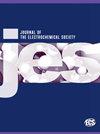Isovalent Co-Substitution of Iron and Titanium into Single-Crystal NMC622
IF 3.3
4区 工程技术
Q2 ELECTROCHEMISTRY
引用次数: 0
Abstract
Substitutional Li[Ni0.6Mn0.2Co0.2]O2 oxides (known as NMC622) were made by all-dry synthesis with Fe and Ti substituting Co and Mn, respectively. The substitutions were performed in three series, Fe substitution for Co, Ti substitution for Mn, and Fe and Ti co-substitution for Co and Mn, according to the formula Li(Ni0.6Mn0.2−yCo0.2−xFexTiy)O2. The resulting oxides were evaluated as cathode materials for Li-ion batteries. Fe-substitution for Co resulted in increased intersite mixing, resulting in increased polarization and capacity fade. Ti-substitution for Mn also resulted in increased intersite mixing, but the mixing was due to Ti3+ in the Li-layer. As a result, Ti-substituted NMCs had improved capacity retention and reduced polarization. These effects were independent of each other, so that Ti could partially offset the negative aspects of Fe-substitution. Additionally, layered Mn-free Li(Ni0.6Ti0.2Co0.2)O2 (NTC622) was produced as an endmember of this series for the first time with low intersite mixing and superior electrochemical performance in comparison to previous reports. These results demonstrate benefits of all-dry Ti-substitution in NMC and the all-dry synthesis method as an avenue towards new cathode composition discovery.单晶 NMC622 中铁和钛的等价共取代作用
用全干法合成法制备了取代型 Li[Ni0.6Mn0.2Co0.2]O2 氧化物(又称 NMC622),其中 Fe 和 Ti 分别取代了 Co 和 Mn。按照 Li(Ni0.6Mn0.2-yCo0.2-xFexTiy)O2 的公式,分别用 Fe 替代 Co、Ti 替代 Mn 以及 Fe 和 Ti 共同替代 Co 和 Mn 三个系列进行了替代。所得氧化物被评估为锂离子电池的阴极材料。用 Fe 替代 Co 增加了位点间的混合,从而增加了极化和容量衰减。用钛代替锰也会导致晶间混合增加,但这种混合是由于锂层中的 Ti3+ 造成的。因此,以钛替代锰的 NMC 提高了容量保持率并降低了极化。这些影响是相互独立的,因此钛可以部分抵消铁取代的负面影响。此外,作为该系列的末端成员,首次制备出了层状无锰 Li(Ni0.6Ti0.2Co0.2)O2(NTC622),与之前的报告相比,它具有较低的位间混合和优异的电化学性能。这些结果表明了全干法钛替代在 NMC 中的优势,以及全干法合成方法是发现新阴极成分的一种途径。
本文章由计算机程序翻译,如有差异,请以英文原文为准。
求助全文
约1分钟内获得全文
求助全文
来源期刊
CiteScore
7.20
自引率
12.80%
发文量
1369
审稿时长
1.5 months
期刊介绍:
The Journal of The Electrochemical Society (JES) is the leader in the field of solid-state and electrochemical science and technology. This peer-reviewed journal publishes an average of 450 pages of 70 articles each month. Articles are posted online, with a monthly paper edition following electronic publication. The ECS membership benefits package includes access to the electronic edition of this journal.

 求助内容:
求助内容: 应助结果提醒方式:
应助结果提醒方式:


